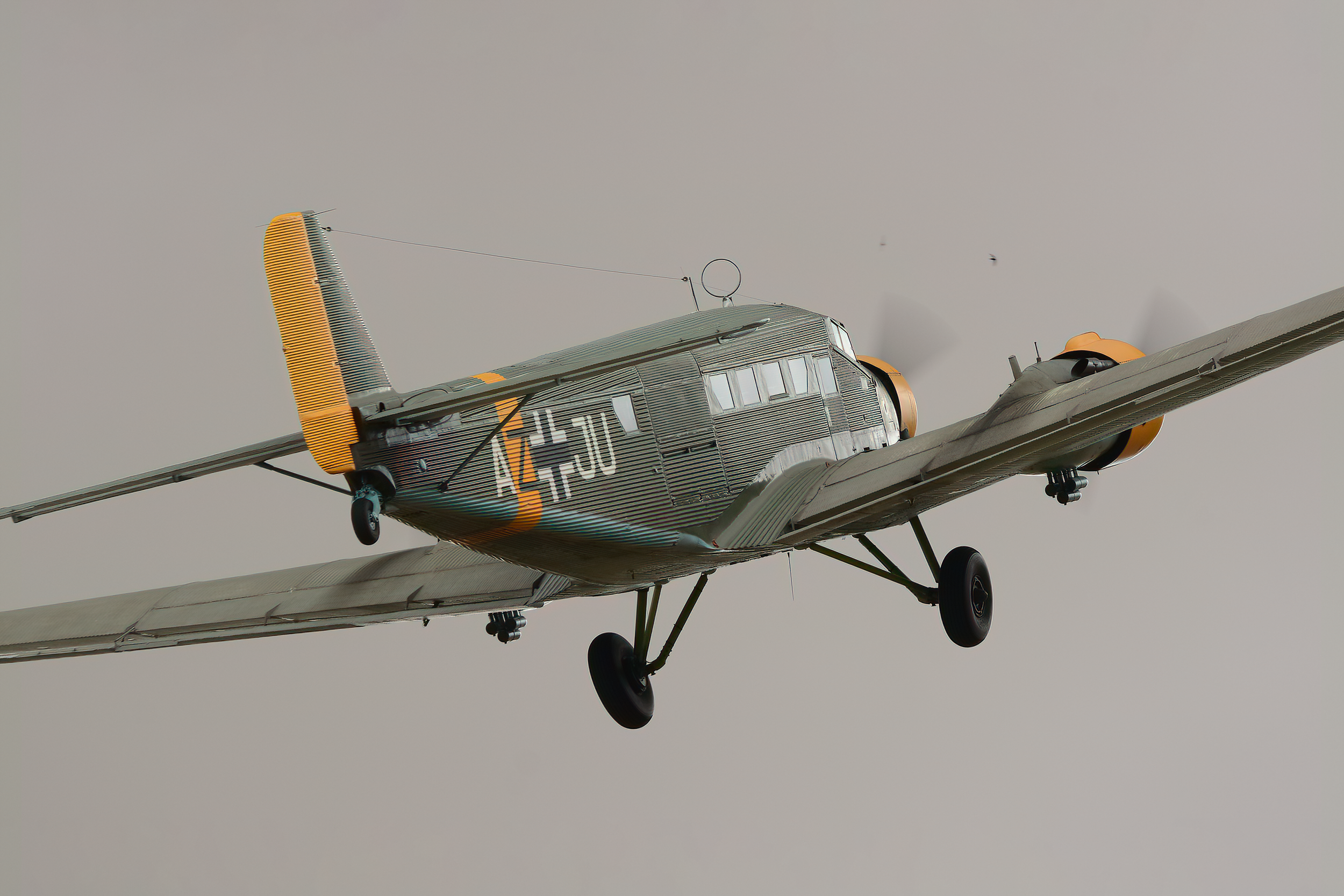
March 7 / Junkers Ju 52/3m first flight
First flight 7 March 1932
Junkers Ju 52/3m
Alright, buckle up and prepare for a wild ride through the skies of history with the Junkers Ju 52/3m, an aircraft so legendary it’s practically the Indiana Jones of aviation—rugged, reliable, and ready for anything. This isn’t just a plane; it’s a corrugated-metal marvel that hauled passengers, dropped paratroopers, and even moonlighted as a bomber, all while looking like it could tell you war stories over a pint. Let’s dive into its tale, starting from its shaky first flight and soaring all the way to its status as a global icon.
The Ju 52/3m’s story kicks off in the early 1930s at the Junkers Flugzeugwerke in Dessau, Germany, where engineering genius Hugo Junkers was dreaming up machines that would change the game. Junkers wasn’t your average tinkerer—he was obsessed with all-metal aircraft, ditching flimsy wood and fabric for duralumin, a lightweight aluminum alloy that was tough as nails. His earlier creations, the single-engine W 33 and W 34, were solid transport planes, but Hugo wanted something bigger, bolder, and more versatile. Enter the Ju 52, a project that started as a gleam in his eye and ended up as a cornerstone of aviation history.
The first stab at this beast was the Ju 52/1m—the “1m” standing for “einmotor,” or single-engine—which took its maiden flight in October 1930. Powered by a BMW-built Pratt & Whitney Hornet radial engine churning out about 550 horsepower, it was a promising start. But here’s the thing: one engine just didn’t cut it. The plane lumbered along, and Junkers knew it needed more oomph to live up to his vision. So, back to the drawing board they went, strapping two extra engines onto the wings to create the Ju 52/3m—“dreimotor,” or three-engine. When this version lifted off in April 1932, it was like the plane had downed an energy drink—it had power, reliability, and a swagger that said, “I’m here to stay.”
That three-engine setup wasn’t just for show. With a trio of engines (usually BMW 132s, licensed versions of the Pratt & Whitney Hornet), the Ju 52/3m could haul up to 17 passengers or a hefty cargo load, and if one engine conked out, the other two could keep it flying. This made it a dream for Deutsche Luft Hansa (DLH), the predecessor to Lufthansa, which snapped it up to expand their routes. The Ju 52/3m didn’t need fancy runways—its sturdy landing gear and low stall speed let it touch down on rough strips, connecting far-flung towns and proving that aviation could go where roads couldn’t.
And boy, did it travel! Beyond Germany, the Ju 52/3m popped up everywhere, from the Andes to the Amazon. In South America, airlines like Lloyd Aéreo Boliviano and Syndicato Condor used it to link remote villages, hauling everything from mail to livestock over mountains and jungles. Its knack for thriving in harsh conditions earned it fans worldwide, and its corrugated duralumin skin became its calling card. That rippled exterior wasn’t just cool to look at—it made the airframe stronger, like giving the plane its own built-in armor. Lightweight yet durable, it was the perfect combo for an aircraft built to take a beating and keep on flying.
But as the 1930s darkened with the rise of the Nazis, the Ju 52/3m’s carefree civilian days took a sharp turn. The Luftwaffe, secretly gearing up for war, saw this reliable hauler as a military goldmine. Its first big test came during the Spanish Civil War (1936-1939), when Germany backed Franco’s Nationalists. The Condor Legion flew Ju 52/3ms to ferry troops and supplies across the Strait of Gibraltar in what’s now called the “Airlift of the Strait”—one of history’s first major airlifts. They even tried using it as a bomber, dropping payloads on Republican targets. It wasn’t great at that—slow and lightly armed, it was more of a sitting duck than a hawk—but it showed the world what air transport could do in a pinch.
By the time World War II erupted in 1939, the Ju 52/3m was the Luftwaffe’s go-to transport. It was the Swiss Army knife of the skies—carrying troops, towing gliders, evacuating the wounded, you name it. In 1940, it starred in the invasions of Norway and the Netherlands, dropping paratroopers and supplies with a precision that left enemies scrambling. Then came the Battle of Crete in 1941, aka Operation Mercury, where hundreds of Ju 52/3ms swarmed the island in a massive airborne assault. It was a brutal slog—anti-aircraft fire and fierce resistance chewed up planes and crews—but the Germans pulled it off, cementing the Ju 52/3m’s rep as a war machine that wouldn’t quit.
German troops dubbed it “Tante Ju” (Aunt Ju), a nickname that oozed affection. It was the reliable aunt who always showed up with supplies or a ride home, chugging along at a leisurely 165 mph with its three engines humming. But as the war dragged on, Tante Ju started showing her age. Faster, deadlier Allied fighters like the Spitfire and P-51 could pick her off like a turkey at Thanksgiving, and her lack of heavy armament didn’t help. Still, Germany kept cranking them out until 1944, building over 4,800 in total—proof that even an old bird could stay relevant when nothing else could fill her shoes.
When the war ended, the Ju 52/3m didn’t just fade away. Allied forces nabbed a bunch and put them to work, while France churned out its own version, the Amiot AAC.1 Toucan, which flew into the 1960s. Spain followed suit with the CASA 352, keeping it airborne until the 1970s. Back in civilian life, it kept chugging along for airlines and tour operators, especially in places like Switzerland, where Ju-Air ran scenic flights until a 2018 crash grounded their fleet. Even today, a few lovingly restored Ju 52/3ms still take to the skies, delighting aviation buffs with their nostalgic rumble.
So there you have it—the Junkers Ju 52/3m, a plane that started as a single-engine dreamer, bulked up to a three-engine titan, and flew through peace and war with grit and grace. Whether you call it Tante Ju, the “Iron Annie,” or just the Ju 52, it’s a flying legend that connected the world, shaped battles, and proved that sometimes, the toughest heroes come wrapped in corrugated metal. From its first flight to its lasting legacy, this is one aircraft that’ll never be forgotten in the annals of the sky.
Junkers Ju 52/3m Facts
Iconic Corrugated Skin: A Design Masterpiece: The Junkers Ju 52/3m boasts a striking corrugated metal skin—a rugged, rippled surface that’s more than just eye-catching. This innovative design choice added exceptional structural strength, transforming the aircraft into a durable workhorse capable of enduring the toughest conditions, whether ferrying passengers or braving wartime skies.
Beloved by Pilots: The "Tante Ju" Legacy: Dubbed "Tante Ju" (Aunt Ju) by German Luftwaffe pilots, this aircraft earned a nickname that oozes affection and trust. Like a reliable family member, the Ju 52/3m became a beloved companion in the air, celebrated for its steadfast dependability across countless missions.
A True Multitasker: From Airliner to Bomber: Imagine an aircraft that could do it all: the Ju 52/3m seamlessly transitioned from a civilian airliner whisking passengers across continents to a military transport—and even a bomber during the Spanish Civil War. Its adaptability made it a chameleon of the skies, thriving in roles few aircraft could master.
Mass-Produced Marvel: Over 4,800 Strong: Between 1932 and 1945, more than 4,800 Ju 52/3m aircraft rolled off production lines, cementing its status as one of the most prolific transport planes of its time. This staggering number reflects its unmatched popularity and the insatiable demand for its rugged reliability.
Pioneer of Airborne Operations: Conquering Crete: In 1941, the Ju 52/3m etched its name in history during the airborne invasion of Crete—one of the first large-scale paratrooper assaults ever. Dropping troops and supplies from its cavernous hold, it redefined warfare, proving the power of wings in military strategy.
Global Reach: A Worldwide Wingspan: The Ju 52/3m didn’t just serve Germany—it soared across the globe! Exported to numerous countries and built under license in Spain (as the CASA 352) and France (as the AAC.1 Toucan), this aircraft’s influence stretched far beyond its homeland, leaving a lasting mark on international aviation.
Decades of Service: Flying into the 1980s: Defying the passage of time, some Ju 52/3m aircraft kept flying well into the 1980s—nearly five decades after their debut! The Swiss Air Force, for instance, relied on them until 1981, a testament to their extraordinary longevity and timeless design.
Still Taking Flight: A Living Legend: Hold your breath—some Ju 52/3m aircraft are still airworthy today! Operated by historical flight organizations, these majestic machines take to the skies, offering a breathtaking chance to witness a piece of aviation history in action, decades after their prime.
Record-Setting Journey: Berlin to Tokyo in 10 Days: In 1932, a Ju 52/3m stunned the world by soaring from Berlin to Tokyo in just 10 days—an astonishing feat for its era. This epic journey showcased its remarkable long-range capabilities, proving it could conquer vast distances with grace and grit.
Mountain Rescue Hero: Saving Lives in the Alps: Picture this: the Ju 52/3m swooping into the rugged Swiss Alps, landing on short, makeshift airstrips to rescue stranded souls. In Switzerland, it became a guardian angel, leveraging its ability to operate in tight, treacherous terrain to perform daring search and rescue missions.







